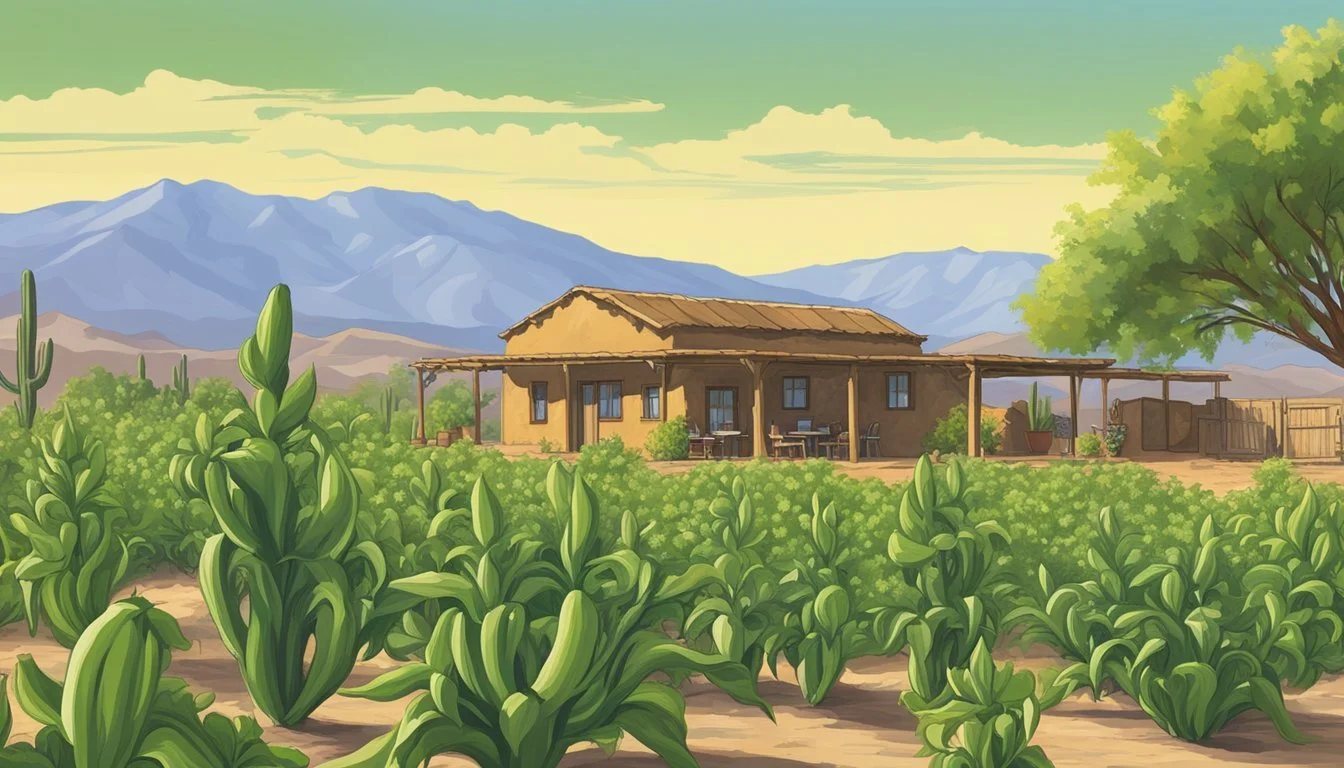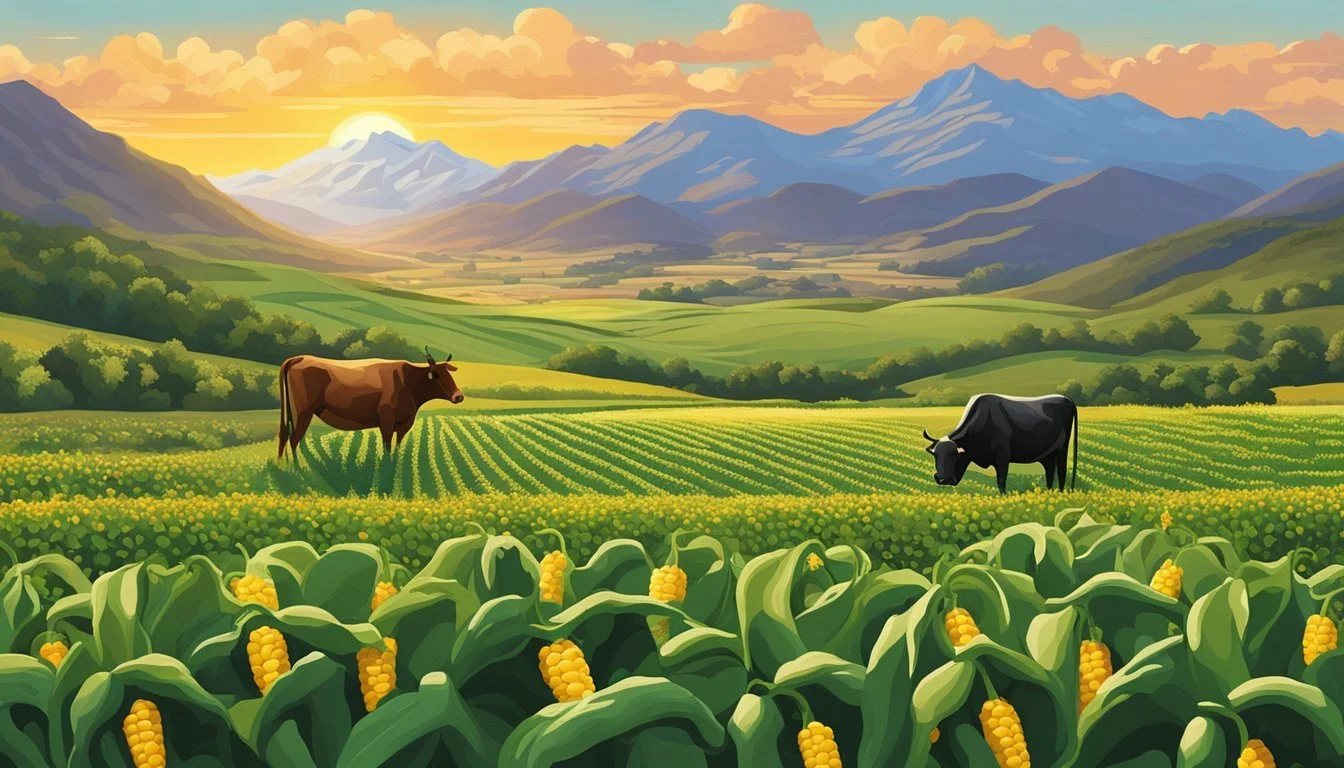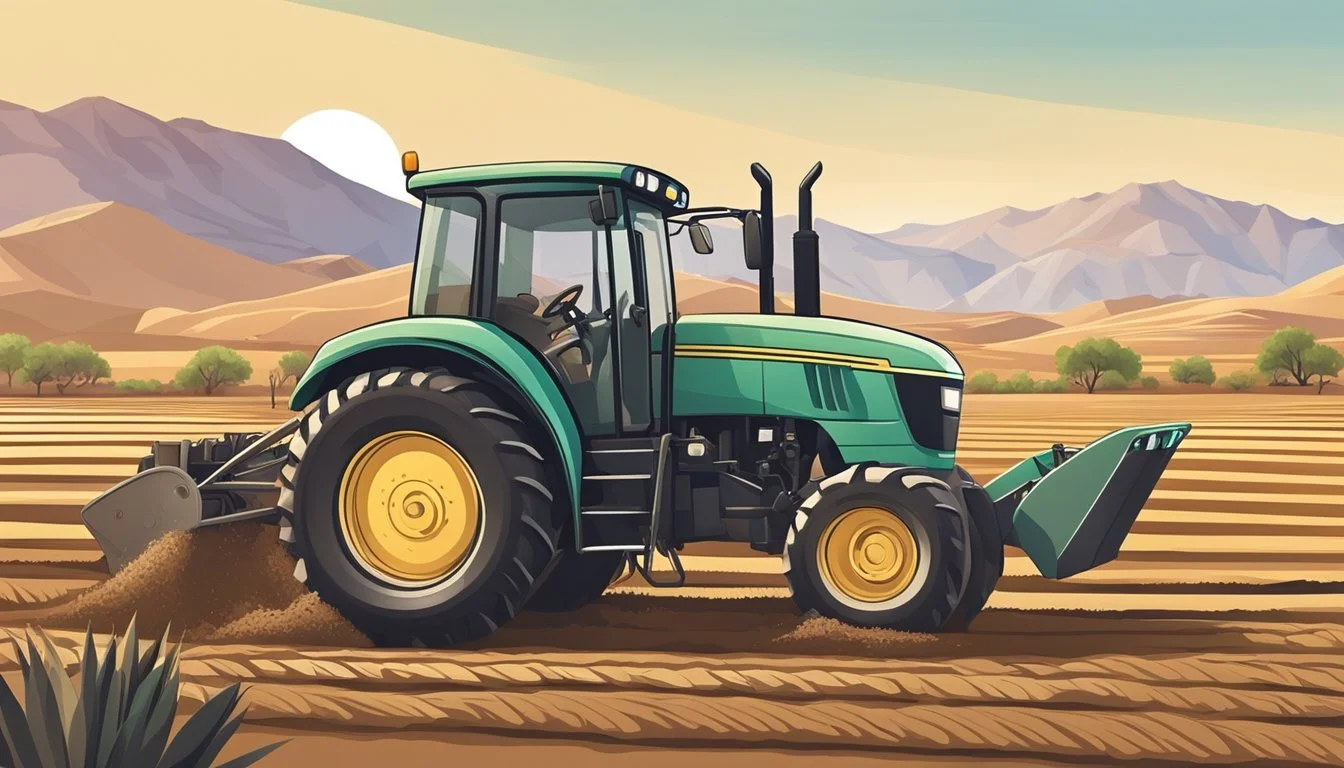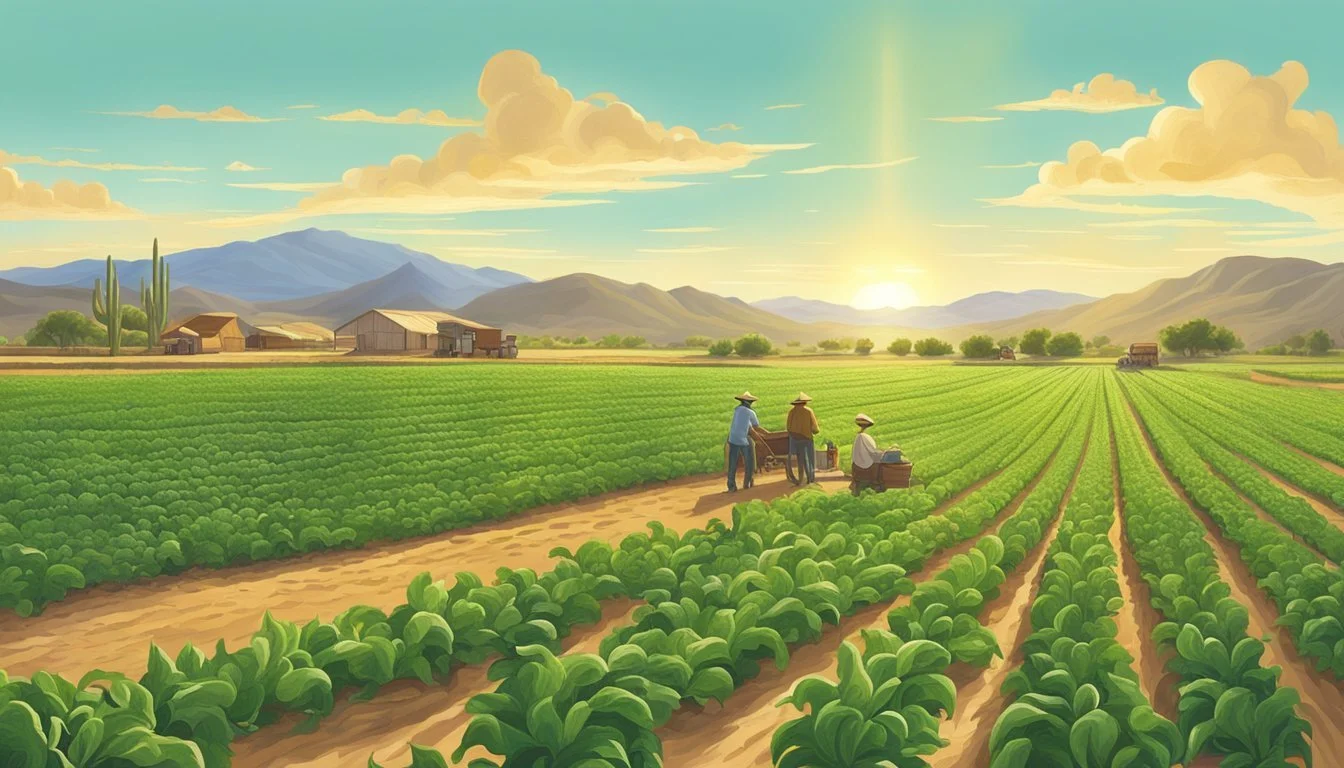Guide to Farming in New Mexico
Essential Tips for Successful Cultivation
This Article is Part of Our State by State Farming Guide
New Mexico's diverse climate and topography make it a unique landscape for home vegetable gardening. The state offers a variety of growing zones, each with its own set of optimal crop varieties, planting times, and harvesting schedules. With the right information and practices, farmers and gardeners can cultivate a range of vegetables and other crops suited to their local conditions.
Incorporating traditional and modern techniques, New Mexico's farmers are well-positioned to take advantage of the state's favorable climate for agriculture. From the well-known cultivation of green chile to the burgeoning market for specialty crops like blue corn, there is potential for both commercial and hobbyist gardeners to succeed. Embracing New Mexico's agricultural diversity and heritage is key to the state's continued success in farming.
Overview of New Mexico Agriculture
New Mexico's agricultural sector is a foundational component of its economy, defined by a rich history and reflected in comprehensive data collected through agricultural censuses. This sector encompasses a diverse range of products and commodities, contributing significantly to the state's economic well-being.
History and Role in Economy
New Mexico’s journey in agriculture dates back centuries, with farming techniques and practices inherited from Native American and Spanish colonial influences. Today, agriculture remains a pivotal industry in New Mexico, sustaining local economies and employment. The state is notable for its family-owned farms and ranches, which represent over 23,000 agricultural operations, accounting for 95% of the industry. Agriculture is not just an economic activity but also a cultural cornerstone that preserves the state’s rich heritage and supports its rural communities.
Census of Agriculture and Statistics
The Census of Agriculture, conducted every five years by the USDA’s National Agricultural Statistics Service (NASS), provides a comprehensive overview of the industry. The most recent census data highlight New Mexico's agricultural output and its significance:
Farms and Operations: 23,000 family-owned farms and ranches
Livestock: A vital component with an extensive inventory
Milk Production: A significant contributor to state revenue
Crops: Diverse, with statistics on area planted, harvested, yield, production, and value
Top Commodities by Value of Production:
Commodity Value of Production (USD) Dairy products Data Not Specified Cattle and calves Data Not Specified Pecans Data Not Specified Hay Data Not Specified Chile peppers Data Not Specified
This statistical data is crucial for understanding trends and making informed decisions that impact both the state's economy and its agricultural producers.
Geographical and Climate Conditions
New Mexico's agricultural success is attributed to its distinctive geographical features and diverse climate conditions, which collectively shape its farming landscape.
Understanding the Growing Zones
New Mexico falls within plant hardiness zones 4b-9a. These zones assist farmers and gardeners in identifying the plants most likely to thrive in their region based on minimum winter temperatures. The state's varied elevation leads to different soil temperatures and conditions that are conducive to a myriad of crops. Planting decisions are often based on this vital hardiness zone information to ensure crop suitability and survival.
Impact of Climate on Farming
The climate in New Mexico is generally classified as semi-arid to arid, which includes hot summers with lower humidity and cold winters. Drought conditions can be a challenge for New Mexico's farmers, influencing water availability and irrigation practices. Farmers in New Mexico must be cognizant of drought patterns and seasonal precipitation levels that typically range from as low as 6 inches in the San Juan Basin to over 46 inches in the Sangre de Cristo Mountains. Adapting farming techniques to accommodate the state's climate helps mitigate risks and make efficient use of available resources.
Key Crops and Livestock
New Mexico's agricultural landscape is diverse, hosting a variety of crops and significant livestock operations, particularly cattle and dairy farming. The state excels in the production of certain specialty crops and maintains a robust livestock sector.
Vegetables and Legumes
New Mexico agriculture provides a range of vegetables and legumes, with chile peppers representing a signature crop. The state's farmers also cultivate a substantial quantity of beans and onions, key components in local cuisine.
Chile peppers: 33% of U.S. production
Beans: Integral part of regional agriculture
Onions: Cultivated extensively due to suitable climate
Fruits and Nuts
Pecans stand out among the fruit and nut category, with New Mexico taking a leading role in national production. The state is responsible for 29% of the U.S.'s pecan output, reflecting its importance to New Mexico's agricultural economy.
Pecans: 29% of U.S. production
Cereal and Fiber Crops
Cereal crops like corn are part of New Mexico's farming industry, though their presence is relatively smaller compared to other states. Cotton and sorghum (how long does sorghum last?) are significant fiber crops, contributing to the state's diverse agricultural profile.
Corn: Grown, though less dominant
Sorghum: Grown for grain and syrup
Cotton: A historic crop enduring in regional production
Cattle and Dairy Farming
The cattle industry is a cornerstone of New Mexico's livestock sector, with beef and dairy farming operating as key economic activities. The state's dairy farms are particularly successful, often reliant on feed imported from other states to sustain large herds.
Cattle: Beef production is widespread
Dairy: Robust industry with a network of dairy farms
Farming Techniques
In the diverse landscapes of New Mexico, farming techniques focus on adapting to the region's unique challenges. Optimal soil management, efficient water use, and choosing between organic and conventional practices are at the heart of successful farming in this state.
Soil Preparation and Fertilization
Farmers in New Mexico must prepare their soil to nurture a variety of crops. Soil fertility is often enhanced using fertilizers including organic options like compost or manure and inorganic ones such as synthetic products. Soil preparation involves testing and amendments to balance pH levels and nutrient content. Farmers may use mulches to retain moisture and reduce erosion.
Example Fertilization Schedule:
Spring: Apply balanced fertilizer based on soil tests
Planting: Use starter fertilizer for seedlings
Seasonal: Top-dress crops with compost to boost nutrient availability
Irrigation and Water Management
Water scarcity demands efficient irrigation and water management strategies. The irrigation techniques range from traditional acequias to modern drip or sprinkle systems. Effective water management includes careful planning to allocate water resources sustainably, capture runoff, and practice dryland farming techniques where viable, which rely on rain-fed moisture conservation without irrigation.
Irrigation Methods:
Drip Irrigation: Targeted delivery to plant roots
Sprinkler Systems: Aerial delivery for broad coverage
Acequias: Shared community waterways for equitable distribution
Organic and Conventional Methods
Farmers in New Mexico choose between organic and conventional farming methods based on their goals and resources. Organic methods exclude synthetic pesticides and fertilizers, emphasizing crop rotation, natural pest control, and green manures. Conventional methods may involve GMO plant seeds and the use of chemical inputs to maximize crop yield and manage pests more aggressively.
Farming Practices:
Organic: Utilizes natural materials and emphasizes sustainability
Conventional: Often uses synthetic chemicals for efficiency and control
Incorporating these techniques helps to ensure the longevity and productivity of New Mexico's agricultural landscape.
Crop Management and Optimization
In New Mexico, effective crop management and optimization are crucial in maximizing yields and ensuring the economic viability of a farming operation. This involves strategic measures for controlling pests, weeds, and diseases, implementing precise harvesting practices, and employing careful post-harvest handling to maintain the quality of agricultural products such as sweet potatoes and tomatoes.
Pest, Weed, and Disease Control
Pest management: Farmers utilize integrated pest management strategies to control pest populations, including monitoring pest levels and employing biological control agents.
Weed suppression: Cover crops play a significant role in mitigating weed pressure, thereby reducing the reliance on chemical herbicides.
Disease prevention: Crop rotation and the use of disease-resistant crop varieties are key practices in preventing the spread of plant diseases.
Harvesting Practices
Timing: Harvesting at the correct time is imperative for ensuring the peak of flavor and nutrition, especially for crops like sweet potatoes and tomatoes.
Techniques: Farmers employ both manual and mechanized harvesting techniques depending on the crop's fragility and labor availability.
Post-Harvest Handling
Storage: Adequate storage conditions are essential for maintaining the quality and freshness of produce, with temperature and humidity control being particularly critical.
Transportation: The timely and careful transportation of harvested crops helps in reducing post-harvest losses and maintaining high-quality produce for market.
Seasonal Farming Cycles
In New Mexico, farmers adhere to specific planting and harvesting times, dictated by the state's diverse climate zones. These practices are crucial for optimizing crop yield and health.
Spring Planting
Spring marks the beginning of the planting season in New Mexico. Farmers start sowing seeds of annual and perennial crops as the risk of frost diminishes. Common spring crops include:
Lettuce
Spinach
Peas
Farmers must monitor soil temperature and moisture levels to ensure optimal germination and growth.
Summer Growth
During the summer, New Mexico's warm temperatures foster rapid crop growth. Irrigation strategies are vital as rainfall can be scarce. Summer crops in the state often include:
Corn
Tomatoes
Chile peppers
Farmers work diligently to protect their crops from the intense heat and potential pests.
Fall Harvesting
Fall is the season for harvesting many of New Mexico's famous crops. The state's growing season peaks as temperatures cool, making it ideal for:
Apples
Pumpkins
Squash
Harvest times can vary; farmers stay informed about local conditions to pick their crops at the right time.
Winter Preparations
Winter preparations involve protecting the soil and planning for the next year's crop rotation. Farmers might plant cover crops to enrich the soil or make infrastructure repairs during this quieter time. Although growth slows, some hardy crops, like winter greens, might still be cultivated, depending on the region within New Mexico.
Importance of Indigenous Practices
In New Mexico, Indigenous agricultural practices offer time-tested insights that are both environmentally sustainable and culturally significant. These methods, deeply rooted in Indigenous knowledge, support the preservation of traditional foods and enhance the resilience of farming techniques in the face of challenging climatic conditions.
Traditional Foods and Cultivation
Indigenous peoples in New Mexico have long cultivated traditional foods such as blue corn, amaranth, and various native melons. These foods are not only integral to cultural heritage but also offer nutritional benefits and are inherently suited to the local environment:
Blue Corn: A staple in Native American diets, it is revered for its high protein content and adaptability to arid conditions.
Amaranth: Once a sacred food to Indigenous people, it stands out for its drought-tolerant qualities and high nutritional value.
The revival of Native American peaches and the sustained cultivation of these crops provide a living link to heritage and a means of food sovereignty.
Sustainable Techniques
Indigenous farming practices emphasize sustainability and alignment with the natural world. For example, farmers:
Embrace polyculture: the planting of multiple crops in the same space to promote biodiversity and soil health.
Intercropping: growing two or more crops in close proximity to maximize space and complement plant growth patterns.
By adopting such practices, Indigenous farmers combat the effects of climate change and reduce the reliance on artificial inputs. This approach not only preserves the soil but is instrumental in creating a resilient agricultural system capable of withstanding drought and other environmental stressors. These sustainable techniques originate from a deep understanding of the local ecology and are a testament to the ingenuity of the Indigenous people who have thrived on this land for centuries.
Economic and Community Impact
Agriculture is a cornerstone of New Mexico's economy, contributing significantly to its financial stability and supporting the fabric of local communities. Farmers and ranchers in the state work tirelessly to maintain the vitality of this sector.
Support for Local Farmers
The National Agricultural Statistics Service regularly reports on the performance of local farmers, reinforcing the economic growth they foster. In New Mexico, agriculture's economic impact is substantial, with a reported $40.23 billion effect on the economy. This includes both direct contributions from farm cash receipts and indirect effects from related industries. Importantly, local farmers drive the production of commodities such as onions, a top commodity with a production value of $128.2 million.
Agriculture's Effect on Communities
The presence of a robust agricultural sector has proven to have a positive influence on New Mexico communities. Financial earnings from agriculture support local families, ensuring the state's economy can prosper. Moreover, agriculture plays a pivotal role in defining the culture of the state, fostering a sense of unity and shared purpose. Efforts are made to ensure the resilience of agriculture for future generations by addressing water and land use challenges critical to the sustainability of farming practices. As agriculture thrives, it propels the economic growth of the communities it serves, translating into advancement for rural and urban areas alike.
Agricultural Education and Innovation
In New Mexico, the pathway to a robust agricultural sector is paved with education and innovation. The state recognizes the critical need to educate the next generation of farmers and agricultural professionals, offering a range of degrees that cater to various facets of the industry. New Mexico State University (NMSU) is at the forefront, offering comprehensive Bachelor of Science programs in Agricultural and Extension Education, which include specializations in Agricultural Communications, Agricultural Education Teaching, and Agricultural Extension/Community Development.
Innovative Practices and Technology:
NMSU's Sustainable Agriculture Research and Education (SARE) program collaborates with local farmers, ranchers, and researchers. This partnership focuses on developing farming and ranching systems that balance profitability, environmental stewardship, and community well-being.
'GreenAI' technology represents a significant leap forward in precision farming. It equips farmers with AI-driven sensor modules for crop monitoring—identifying issues like disease, pest infestations, and nutrient deficiencies.
Educational Opportunities:
Degree Programs: Focus areas include agricultural communications, teaching, and community development.
Strategic Plans: Initiatives aim to bolster the number of individuals entering farming and ranching careers through enhanced education and training opportunities.
Research and Grants:
Competitive grants foster research that benefits local agricultural professionals.
This dedication to agricultural education and innovation ensures that New Mexico's farming communities are not only sustaining traditional practices but also embracing new technologies to meet the demands of modern agriculture.
Marketing and Export of Agricultural Products
In New Mexico, the marketing and export of agricultural products play significant roles in connecting its diverse farm production with national and international markets.
Doña Ana County's Chile Pepper Acreage
Doña Ana County is renowned for its vast chile pepper acreage, where the emphasis on green chile roasting is not merely a cultural tradition but also a vital contributor to the agricultural economy. Food processing facilities in the area focus on handling the distinct varieties of chile peppers, many of which bear the coveted distinction of the New Mexico chile. Producers in the county have experienced success both in domestic sales and in exporting these iconic chiles, which are celebrated for their unique flavor profiles.
New Mexico's Role in the National Market
As a state, New Mexico commands an important position in the national agricultural market, especially with its dairy products, pecans, and hay. It is not just about the internal production; the state has established marketing initiatives aiming to elevate the presence of its agricultural goods in markets across the United States and beyond. The New Mexico Department of Agriculture offers various programs to facilitate the international marketing efforts of local agribusinesses, thereby expanding their reach and connecting with global consumers. This assistance is crucial in amplifying New Mexico's agricultural narrative and its quality products on a large scale.











